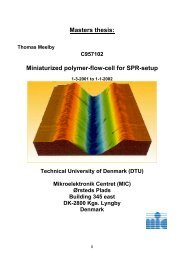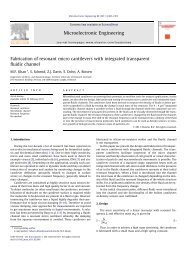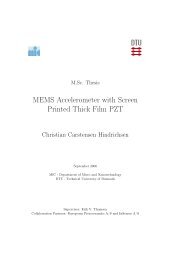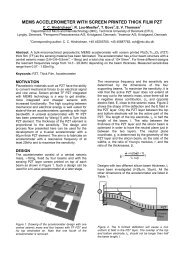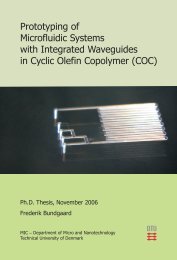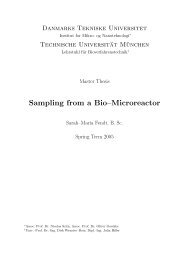Development of a Oxygen Sensor for Marine ... - DTU Nanotech
Development of a Oxygen Sensor for Marine ... - DTU Nanotech
Development of a Oxygen Sensor for Marine ... - DTU Nanotech
Create successful ePaper yourself
Turn your PDF publications into a flip-book with our unique Google optimized e-Paper software.
3.1. CHEMISTRY OF THE CLARK SENSOR 19<br />
The pressure pr<strong>of</strong>ile within the membrane and the current output under<br />
steady state conditions can then be obtained from Eq. 3.5 and Eq. 3.8:<br />
and<br />
p<br />
p0<br />
= x<br />
dm<br />
I = NF A Pm<br />
dm<br />
· p0<br />
(3.9)<br />
(3.10)<br />
At steady state, the pressure pr<strong>of</strong>ile is linear and the current output is<br />
proportional to the oxygen partial pressure in the bulk liquid, where Eq. 3.10<br />
<strong>for</strong>ms the basis <strong>for</strong> DO measurement by the sensor. The response time <strong>of</strong> the<br />
sensor as seen from Eq. 3.8 is:<br />
τ = d2 m<br />
Dm<br />
(3.11)<br />
Where τ determines how fast the sensor responds, due to the thickness<br />
<strong>of</strong> the membrane or a high Dm. However these conditions tend to weaken<br />
the assumption <strong>of</strong> membrane-controlled diffusion. There<strong>for</strong>e, a compromise<br />
has to be made <strong>for</strong> optimum sensor per<strong>for</strong>mance. Changing dm (rather than<br />
Dm) is more effective in adjusting τ (since it depends on the square <strong>of</strong> dm).<br />
Eq. 3.10 and Eq. 3.11 gives the indication, that the design variables <strong>for</strong> a<br />
DO sensor is Pm, dm, Dm, and A.<br />
3.1.2 Two layer model<br />
The problem is, however, that the second assumption, made earlier in this<br />
chapter, is not entirely accurate. A stagnant liquid film will almost always<br />
exists right outside the membrane even at high liquid velocities.[28] Hence<br />
a more realistic model have to be made, in order to account <strong>for</strong> this film as<br />
shown on Figure 3.4. This take into consideration the effect <strong>of</strong> the film, as<br />
it slows down the diffusion through the membrane.<br />
The effect <strong>of</strong> the liquid layer on the sensor current can be calculated by<br />
expanding the previous model, at steady state the oxygen flux J through<br />
each layer should be the same.



